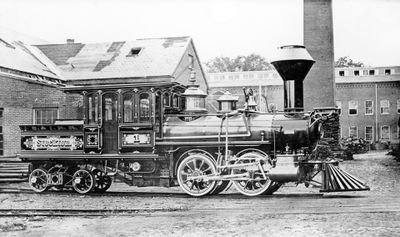Difference between revisions of "Mason-CN551-1875"
From PacificNG
m |
|||
| (One intermediate revision by one other user not shown) | |||
| Line 4: | Line 4: | ||
<span style="float:right;">__TOC__</span> | <span style="float:right;">__TOC__</span> | ||
[[File:SI-Stockton-Builders-Photo.jpg|400px|left|thumb|''Stockon'' at the Mason Machine Works factory.]] | [[File:SI-Stockton-Builders-Photo.jpg|400px|left|thumb|''Stockon'' at the Mason Machine Works factory.]] | ||
| Line 27: | Line 31: | ||
The ''Stockton'' arrived at it's namesake in August 1875. After the Stockton & Ione failed the locomotive was sold at Sheriff's auction to a promoter of the [[Seattle & Walla Walla Railroad]] in October 1876. | The ''Stockton'' arrived at it's namesake in August 1875. After the Stockton & Ione failed the locomotive was sold at Sheriff's auction to a promoter of the [[Seattle & Walla Walla Railroad]] in October 1876. | ||
==== | ====Seattle & Walla Walla Railroad==== | ||
On the Seattle & Walla Wall it was named ''“A. A. Denny”'' but found to be top heavy and troublesome. In 1878 it was rebuilt from an 0-4-4T into a 0-6-4T at the railroad's shops in Seattle and continued to serve the railroad through the 1890s. | On the Seattle & Walla Wall it was named ''“A. A. Denny”'' but found to be top heavy and troublesome. In 1878 it was rebuilt from an 0-4-4T into a 0-6-4T at the railroad's shops in Seattle and continued to serve the railroad through the 1890s. | ||
Latest revision as of 09:26, 3 August 2021
History
Built by the Mason Machine Works in 1875 for the Stockton & Ione Railroad of California.
Service
Stockton & Ione Railroad
The Stockton arrived at it's namesake in August 1875. After the Stockton & Ione failed the locomotive was sold at Sheriff's auction to a promoter of the Seattle & Walla Walla Railroad in October 1876.
Seattle & Walla Walla Railroad
On the Seattle & Walla Wall it was named “A. A. Denny” but found to be top heavy and troublesome. In 1878 it was rebuilt from an 0-4-4T into a 0-6-4T at the railroad's shops in Seattle and continued to serve the railroad through the 1890s.


